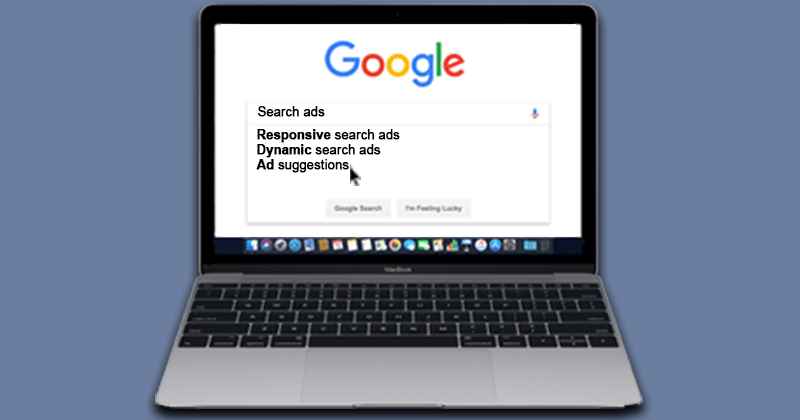Responsive Search Ads, Dynamic Ads and Ad Suggestions

Are Google and Bing trying to make digital marketers an endangered species? Recently, Google rolled out Responsive Search Ads, which depend heavily on machine learning and reduce a great deal of work around testing for the advertiser. Arguably, both companies have moved towards more machine-generated ad types for years (Dynamic Ads have been around since 2011). So, to answer my own question: Yes, of course they are! But that’s nothing to fear. In fact, these new ad types can help make you and your digital marketing strategies more successful. The future is here, and it’s brighter than you think.
Ad Suggestions: You’re Still in Control
Ad Suggestions are just as they’re called — suggestions made by Google based on your existing ads, extensions, landing pages, keywords, and search queries (and for all you Bing lovers out there, Bing has a similar ad type, called Ads By Bing ). Ad Suggestions are generated via machine learning but they are also subjected to human review on Google’s end. Ad Suggestions can therefore be like having another team member, another brain to come up with possible ads that might work to increase traffic. According to Google, 3 or more high-quality ads can increase clicks or conversions by 5 to 15 percent over ad groups with only one ad. So, if you’re unable to think of more ads, or your team is small, Ad Suggestions can be a great way to expand the possible effectiveness of your campaigns. Of course, it’s not all good. There is a downside. When Google makes an ad suggestion, you are notified and you can choose to apply, edit or dismiss them, but if you do nothing they will automatically apply after 14 days. So, you must stay on top of them and pay attention to your notifications. Overall though, it’s worth the risk and worthy of experimentation. If, at the end of the day, you find the suggestions never work for you, you can always turn the feature off.
Dynamic Ads: Expand Your Capabilities
Dynamic Ads are ads, as the name also suggests, which are dynamically created via Google crawling your website. In this instance, you provide the body copy and the website URL that you want to target (which you must own). Google (or Bing) will then dynamically create a headline based on the search query and frequently used phrases on your website. You can tell Google which part of your website you want to focus on by using landing pages from your ad groups, or categories of different topics on your site, or you can upload a spreadsheet of URLs. The end result is that Dynamic Ads give a much better match between search query, headline and landing page, thereby potentially increasing your click-through rate.
If you have a large inventory, constantly changing products or even a robust content marketing program with 100s of blogs, Dynamic Ads can reduce your workload as you would not have to create ads for each product (or post). Even if you don’t have a large inventory of products, Dynamic Ads can also capture unique searches for keywords you might never have thought of thereby extending your reach. We often deploy Dynamic Ads for this very reason and then review for which headlines Google created and are working, which has helped us build out net new ad copy. But be warned: garbage in, garbage out. If you have a poorly optimized website, Google will give you poorly optimized Dynamic Ads. And as much as it helps you to capture unique searches, Dynamic Ads might also show for less relevant searches, so you’ll need to make use of negative keywords. In the long run though, Dynamic Ads are a great way to supplement your existing efforts and are worthy of experimentation.
Responsive Search Ads: Amplify Your Efforts
Responsive Search Ads dynamically combines headlines and descriptions, using machine learning to help advertisers test out which is the best performing combination. There are even more insights available since Google increased the character limit for search ads, thereby giving advertisers more space to play with (there are three 15 character headlines available and up to two 90 character descriptions). The idea behind Responsive Search Ads is that you’ll have more opportunity to compete for different keywords (because there are more options to trigger the keywords) and you’ll display more relevant ads to search queries because of the extra real estate and all that testing, all of which should increase your click-through rate.
Google claims that advertisers will experience a 5 to 15 percent lift in click-through rate in comparison to Extended Text Ads. Advertisers can use up to 15 headlines and four descriptions, which can appear in any of the positions (i.e. one headline can display in the first, second or third headline position). Of course, it does mean that you will need to make sure all the language and verbiage make sense as much as possible with all the different combinations (which works out to a whopping 43,360 variations). Google also lets you pin headlines and descriptions to certain positions, thereby ensuring a certain message always appears in your ad. Certainly, most human brains that work in your average marketing department can’t review 43,000 ad variations, so Responsive Search Ads can test and try variations that you might not have thought of thereby amplifying your efforts to understand what resonates more with your audience. We think this is definitely worth a try.
Here’s some other blog posts you might find interesting:
